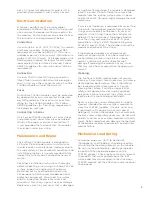
array. Using metal components could result in
grounding requirements and a safety hazard.
Electrical Installation
Whenever possible use the jumper cables
provided by Sunflare. They are cut to the correct
size and have the proper mating connectors for
the modules. For making homerun cables follow
the instructions and requirements below.
Conductors
Use only USE-2 or UL 4703 “PV Wire” for jumpers
and homerun cables. These wires meet NEC
requirements per Section 690.31 (C) for use in
outdoor exposures in solar arrays. Minimum wire
gauge is AWG 12 (4mm2). Use larger gauge wire
(lower gauge number) for longer runs or where
reduced electrical resistance is desired. Follow
all NEC guidelines for wire size and installation
requirements.
Connectors
Use only Multi-Contact MC4 plug connectors
from Staubli (www.staubli-alternative-energies.
com). Using any other connector with a Sunflare
FLEX60 module will void the warranty.
Fuses
All Sunflare FLEX60 modules must be protected
by appropriate overcurrent protection devices
per NEC guidelines. The maximum series fuse
rating for the FLEX60 module is 12A. Follow
all NEC guidelines for fuse rating requirements
including size and type.
Connecting in Series
Only connect FLEX60 modules in series strings
and protect each series from other paralleled
strings with proper overcurrent protection. It
is reccomended that no more than 25 modules
should be in series per string.
Mechanical Load Rating
For design purposes, ASC7-16 Section 30
“Components and Cladding” should be used for
calculating the load requirements on the module.
Do not use the photovoltaic specific paragraphs
in Section 29 for load development on the
FLEX60 product. Those sections are only relevant
to products that are mounted above the roof
surface and thus do not apply to the stick down
FLEX60 module. Set the effective wind area equal
to one panel.
Maintenance and Repair
The Sunflare FLEX60 module is designed for
a 25-year life and under normal circumstance
should require no maintenance. However, due to
the wide variety of environmental conditions and
installation practices it is recommended to fully
inspect the system and all connections every 6
months.
Read these installation instructions thoroughly
before inspecting or servicing a Sunflare FLEX60
system. Inspection and service should only
be carried out by qualified personnel using
all appropriate OSHA recommended personal
protection equipment. Disconnect the system
prior to inspection. Replace any wires and
connectors that shows signs of wear or damage.
Replace any wire tray and cover that is damaged
or significantly degraded. If a module is damaged,
leave it in place. Do not attempt to remove the
module from the roofing surface unless it poses
an electrical risk. Doing so might damage the roof
membrane.
If service or inspection is required, disconnect the
string with the damaged module from all other
strings and use black out blankets to cover all
modules in that string. Check that voltages are
below 5V. Then, disconnect the broken module
from the string and plug the ends of its j-box
connections using the MC4 Staubli sealing caps
PV-BVK4, and PV-SVK4. Then jumper around the
module and reconnect the string.
If the damaged module has compromised
electrical encapsulation it can be removed or
encapsulated in place using a black silicone
sealant. Sunflare will not be liable for roof
damage if removing the module nor any issues
that may arise from encapsulation by applying a
sealant.
Cleaning
The Sunflare FLEX60 module does not require
cleaning. If cleaning is found necessary to achieve
desired power performance, then it should only
be cleaned by professional cleaners. Prior to
cleaning the system, it must be inspected for
safety and approved for cleaning by qualified
personnel. Failure to inspect the system could
lead to electric shock and possibly death.
Never use brushes, soaps, detergents or robotic
cleaners intended for use over glass modules to
clean the FLEX60 modules. Use only water, and
if required a soft sponge. Do not use soap or
detergents to clean the module. Do not walk onto
the array unless absolutely necessary. Do not walk
on dirty modules or over clean modules with dirty
shoes. Debris underfoot can damage the topsheet
of the module leading to power loss and possibly
module failure.
10

































